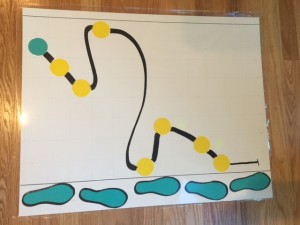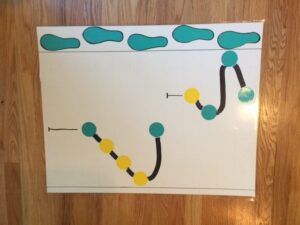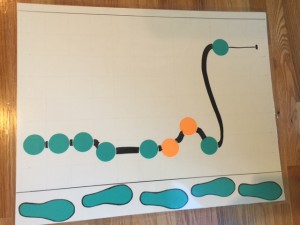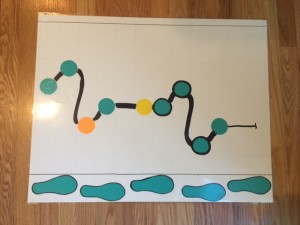What do you see? What do you notice?
The children look at the posters and give their answers. Some will name the shapes, some will say it has some thing to do with loud or soft of the song, and some will even say it has to do with the ups and downs of the melody.

What does this map have to do with the song I am singing?
I sing the song through once and receive the children’s answers. Because the posters are not in order (on purpose), I ask the children which one of the posters comes first. I sing the song again as they work out the puzzle. I keep asking and singing until the children have put them all in order. (Can you tell which of these melody maps comes first, second, third, and fourth?)
What’s the highest note in this song? What is the lowest?
Once the maps are put in order, have the children look to see if they can find the highest note and the lowest notes of the song. Now have them listen to the song as you sing and tell you what word comes on the highest note and the lowest note.
What does this color mean in the song?
I use my finger to point to the different circles as I sing. I ask “What do these different colors mean in this song?,” then I receive the children’s answers about what the colors mean on the map.
What does the yellow mean? What does the orange mean? (I sing the song again and emphasize the words associated with that color to help them figure it out.)
(Yellow = words about the Savior)
(Orange = words about us)
Can you sing only the yellow?
Ask the children to sing only the words with the yellow and you will sing all the rest of the words. Now switch and you sing only the yellow, and the children sing all the rest.
(What they don’t realize is that they are learning to sing the song with their inside voice, a very strong musical skill, and one that is terrific for memory.) This is a great activity for the children!




Michelle
I remember that you presented this at your workshop in March, and I did it with my children a couple weeks ago. They loved it!
Chelsea Keith
We did this today as a review and our primary LOVED it! We were able to SING, SING, SING, SING and they didn’t even notice we sang Come Follow Me 7 times in a row!
Bethany S Stuart
Do you recommend melody maps for younger children? I was going to use this next month but we will be combining all our kids.
Sharla Dance
I do recommend using it with younger children. I don’t put them out of order, though, like with the older children. I have small pictures of the Savior on the side. When I ask what is the highest note, I have a child that I have tapped on the shoulder come up and put the small picture on that circle. When I ask what the orange circles are for, I have the children answer what they think, then I have another child come up and put a small picture on those circles.
It is much more simple, not as much symboling, and more interactive by putting up the small pictures on the melody map. Also, when I sing the melody, I trace the ups and downs with my finger (which I don’t do with the older).
Thanks for asking!
Alisa
This idea sounds so fun! I can’t find the instructions on how to make a melody map though. Can you help?
Sharla Dance
Here is post on how to make a melody map. http://teachingprimarymusic.com/how-to-make-a-melody-map/
Thanks for asking.
Lynn Christine Slocum
Why is footsteps outlined in darker? I am thinking it relates to the footsteps below? Thanks!
Sarah Funk
Hi! Thank you so much for this! I’m having trouble decoding the maps :/ I can’t recognize the melody in any of the posters, I’m sure it’s a silly miss, but can you help me decode this? What are the straight lines, the footprints for, and what is the proper order of the maps? Thank you!
Debbie Neff
I am a new Stake Primary president and went and visited some of the other wards and they where using these wonderful ideas, I really want to share them with everyone the spirit was so strong when they sing. Thank you